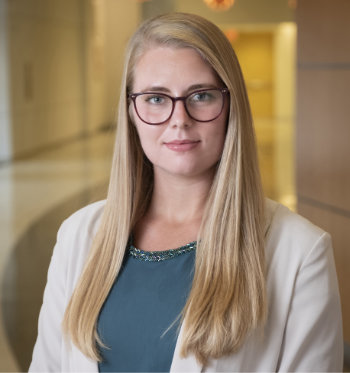Samantha (Sam) LisyAuthor: Courtney Whilden  We have all seen the stereotypical portrayal of a scientist’s journey. A child takes interest in science at a young age, proceeds to dedicate every waking moment to becoming a scientist, and is then destined to a lifetime of solitary lab work. Former elite swimmer, now RNA biologist, Samantha (Sam) Lisy challenges the idea that the best path to a scientific career is linear. Now a PhD candidate in Biochemistry at Vanderbilt University in Nashville, Tennessee, Sam describes how her “elite-athlete turned scientist journey” has instilled in her a strong work ethic, unbridled curiosity, and secure identity and community outside of the laboratory. Sam completed her undergraduate work in chemistry at Indiana University while training and competing as a division-I collegiate athlete. Referencing her time as a swimmer-student, Sam says, “a lot of my academic career during undergrad was (quite literally) just trying to keep my head above water.” Despite the intensity of her schedule, Sam accumulated an impressive collection of awards and experiences during her time as an undergraduate, ranging from honor society inductions, to working for an Epsom salt bath soak company, to researching in a lab. “Finding a lab that was willing to take me on despite my training schedule was a task,” Sam says. Successful in this task, Sam found a research home in Dr. Yan Yu’s lab, where she worked to understand the effects of microparticles on the immune system. Crediting the training environment at Indiana University for her continued commitment to science, Sam says, “Most labs [at Indiana University] had undergraduate student researchers so it felt like a very “safe” place to start research,” she says. Sam’s positive experience as an undergraduate left her with a passion to continue scientific research, but she did not know exactly what topic she wanted to pursue. “I only applied to interdisciplinary umbrella programs…since I was unsure of exactly what I wanted to study and wanted to have options,” Lisy says. She ultimately found her home at Vanderbilt University. Her choice to attend Vanderbilt for her graduate education was based on her excellent interview experience, where she found the program’s environment “casual, laid back, and unpretentious.” During this process, she interviewed with her future PhD advisor, Dr. Manuel Ascano, and Sam instantly knew that Dr. Ascano’s lab was a perfect match for her. “I love both biochemistry and viruses and wanted a lab that blended the two,” she says. In Dr. Ascano’s lab, Sam has been investigating how an RNA-binding protein contributes to host-pathogen sensing of RNA.
As a current graduate student, Sam spends a lot of time performing experiments and analyzing data; however, she has not forgotten the value of life experiences and community. “To keep my journey as an individual in perspective, I lean hard on my identity and community outside of the lab,” she says. These are not just words from Sam; she truly puts them into practice. Sam trains for and runs marathons in the Nashville community, takes business courses, and serves as a leader in the Biochemistry Student Association at Vanderbilt. “I think finding that holistic identity is so helpful in escaping the comparison cycle and establishing a sense of self-worth separate from science,” Sam says. Referencing the vast support network she has formed from these activities, Sam says, “accomplishing things with community and support is always better than trying to do things alone.” Sam’s research experiences have led her to identify, scientifically, most strongly as an RNA biologist. Sam has attended multiple RNA Society Annual Meetings. She says, “Giving a talk at RNA2023 was pivotal in stepping into my identity as a scientist.” Sam enjoyed talking about her work with other scientists, across all levels of the career ladder. Referencing the imposter syndrome often faced by trainees, Sam describes, “In that moment, my brain clicked. I am very knowledgeable and what I am doing matters.” As RNA biologists, we had to ask Sam about her favorite RNA. “I don’t think I have a favorite RNA, but I do have a favorite RNA modification– the 7-methylguanosine cap!” This choice complements her described interest in viruses and biochemistry. Sam is fascinated by “how viruses use cap structures…to mimic cellular RNA, but also how small perturbations can result in a variety of post-transcriptional regulatory events.” Because of this, Sam’s current favorite RNA article is “The Molecular Language of RNA 5’ ends: guardians of RNA identity and immunity.” She describes this article as “a one-stop-shop summary for a lot of the papers important to my project. The 5’ end is such an important place for RNA regulation.” Sam hopes to find a career in industry after her PhD, and there is no doubt that her commitment to her holistic identity will be an asset in this pursuit. Sam’s story serves as inspiration for anyone wanting to embark on a scientific career without giving up the experiences in life that are important to them. The cartoonish portrayal of the obsessed, lonely scientist is not reality, and our unique backstories and communities outside of the lab ultimately make the field stronger. |
